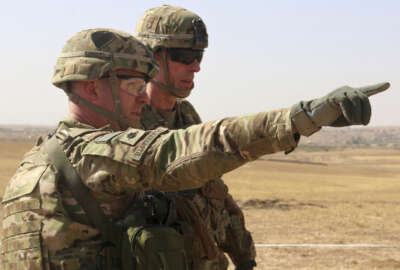
Air Force unveils health care overhaul to narrow focus on airmen deployability
The Air Force is shifting to more preventative medicine and creating a medical squadron focused on active-duty airmen.
Best listening experience is on Chrome, Firefox or Safari. Subscribe to Federal Drive’s daily audio interviews on Apple Podcasts or PodcastOne.
The Air Force is overhauling the way it delivers health care to active-duty airmen in order to deliver “laser focus” attention to military health needs and ailments.
The point of the reform is to add more preventative and personalized care to airmen, so they can stay ready or get back on ready status sooner.
“This clearly delineates out our two missions we’ve had in the past of delivering healthcare to our beneficiaries, which includes our airmen and then also delivering medical readiness,” Lt. Gen. Dorothy Hogg, Air Force surgeon general, told Federal News Network last Friday at the Pentagon. “This model now clearly takes those two missions and identifies the functions that fall under those two missions, so we can focus in on them and make both of them as efficient and effective as we can.”
Hogg said the new model will improve care to non-active-duty airmen and to active duty.
Under the model, dedicated provider care teams will be assigned to an operational medical readiness squadron, which focuses on active-duty issues and improving readiness.
That squadron will keep its eye on military unique requirements that non-active-duty beneficiaries don’t need to be concerned with.
“Those things include preventative health assessments once a year, medical narratives for someone going to a medical board to see if they are still fit for duty,” Hogg said. “Those things were intertwined into the delivery of the benefit for all, which can take some time. That will be delineated out.”
Active-duty squadrons will also have their own primary care manager assigned to them.
“The manager will get to know that squadron, get to know those units, understand the stressors that apply to them and be able to proactively mitigate those stressors to mitigate stress or injury,” Hogg said.
The goal is to have one primary care manager per 1,100 airmen.
“That provider will have been out in the squadron,” Hogg said. “If someone comes in with back pain, the provider can go ‘I know what you do. Let’s talk about how you do it and maybe I need to send you to physical therapy, not to treat the pain necessarily, but to keep yourself from getting back pain or making it worse.’”
A separate health care operations squadron will care for non-active duty patients and the families of service members.
There are currently five Air Force clinics that already transitioned to the new model. The plan is to have 43 military treatment facilities transitioned by the end of the summer and the rest of the Air Force by the end of 2020.
The model is based off a pilot program in the 366th Medical Group at Mountain Home Air Force Base in Idaho. The program treated the 366th Fighter Wing.
“We had more than 400 Airmen on the base who were considered ‘non-mission capable’ when we launched in March 2018,” said Col. Steven Ward, the former 366th Wing Surgeon General. “In six months, we reduced that number by nearly one-fourth. Our provider teams focused relentlessly on getting airmen back into the fight.”
Provider teams were able to holistically treat airmen instead of waiting for an Airman to seek out care. They visit with airmen in their duty locations to understand the personal and workplace challenges they face, and partner with unit leaders to proactively manage airmen’s care and minimize downtime.
“It was a real culture change for our provider teams, focusing just on airmen and building relationships with their assigned squadron and leadership,” said Ward. “That narrow focus really helps providers get to know their patients and solve health problems before they can negatively affect the mission.”
Hogg said the Air Force was looking at this policy even before the Defense Department required service members who are nondeployable for a year or more to leave the military.
“This whole reform, not just the Air Force reform, but the reform of the military health system, gave us an opportunity to clearly identify who is responsible for the benefit and who is responsible for readiness,” Hogg said. “I can really focus in now on paying attention 100% to the mission capably rate of my human weapons system.”
The military health system reform Hogg is referring to is the creation of the Defense Health Agency and the movement of military treatment facilities from the services to that agency.
Hogg said the Air Force will be looking at the mission capable metrics of its airmen to find out where they stand on health, immunizations, dental checkups and everything else.
If airmen are not mission capable, the issue that is keeping them from being deployable will be individually case managed by the operational medical readiness squadron.
“Every airmen will be individually case managed for what their issue is that is keeping them from being fully mission capable to make sure they are getting the appointments and referrals they need,” Hogg said.
Preventative care
The military as a whole is beginning to embrace preventative care more, instead of treating injuries and illnesses as they arise.
The Army changed it physical fitness test to encompass exercises that were less stressful on the body and DoD is looking into ways to protect service members’ brains from weapon recoil.
Hogg said the shift in care comes from the recruits.
“The pool of our applicants that might want to come into the military’s health is dwindling,” Hogg said. “We need to be more focused on making sure not just that our own population is as healthy as it can be, but also bleeding over into some of the non-active-duty population to be as healthy as they can be. We can’t do our mission without airmen.”
One of the things the Air Force is looking into is providing sensors to non-mission capable airmen so they can be monitored 24/7 at any location.
The Air Force is also putting emphasis on healthier eating and injury prevention.
“What we are looking at is how we get out there and identify those environmental or occupational issues that have the potential to cause disease or injury and how do we prevent that?” Hogg said. “It’s mostly through education. How can we teach them to lift better or run better? We have running clinics to watch people run and teach them what kind of shoes to wear. Occupationally, what are they being exposed to and what do we need to give them that decreases that exposure. Earplugs when you’re exposed to noise. Breathing devices when you’re exposed to toxic fumes.”
Copyright © 2025 Federal News Network. All rights reserved. This website is not intended for users located within the European Economic Area.
Scott Maucione is a defense reporter for Federal News Network and reports on human capital, workforce and the Defense Department at-large.
Follow @smaucioneWFED
Related Stories





